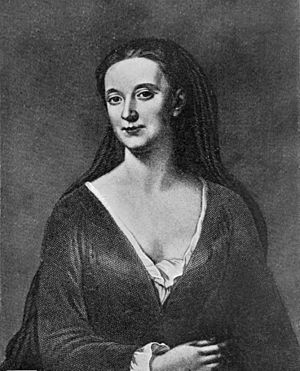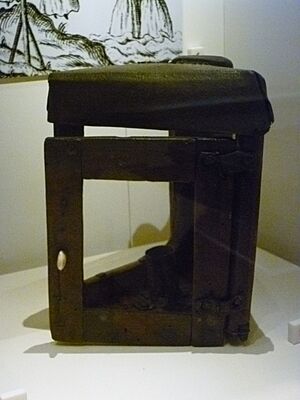Lady Grizel Baillie facts for kids
Quick facts for kids
Lady Grizel Baillie
|
|
|---|---|

|
|
| Born | 25 December 1665 |
| Died | 6 December 1746 (aged 80) |
| Nationality | Scottish |
| Occupation | songwriter |
|
Notable work
|
Were na my heart licht I wad die |
Lady Grizel Baillie, born Hume, (December 25, 1665 – December 6, 1746) was a Scottish noblewoman and a talented songwriter. She kept detailed records of her household for over 50 years. These records are like a time capsule, giving us a peek into what daily life was like in Scotland during the 1700s.
Contents
Lady Grizel Baillie's Life Story

Grizel Hume was born at Redbraes Castle in Berwickshire. She was the oldest daughter of Grisell Ker and Sir Patrick Hume. When Grizel was twelve, her father was suspected of being involved in a plot against the king. This plot was known as the Rye House Plot.
Grizel bravely carried secret letters for her father. She even smuggled food to him when he had to hide in the crypt of Polwarth Church. After her father's friend was executed, her family had to flee to the Netherlands for safety. They returned to Scotland after the Glorious Revolution. This was a time when a new king and queen came to power.
In 1692, Lady Grizel married George Baillie. They had first met when they were both twelve years old. It is said they fell in love back then. After returning to Scotland, Lady Grizel was offered a job as a maid of honour to Queen Mary. However, she turned it down. She insisted on marrying George Baillie, even though her parents wanted her to marry someone else who might have brought more money or status.
Lady Grizel and George had two daughters. Their first daughter, Grizel (1692–1759), married Sir Alexander Murray in 1710. Their second daughter, Rachel (1696–1773), married Charles Lord Binning in 1717. They also had a son named Robert, who sadly lived only a short time. Lady Grizel Baillie passed away in London on December 6, 1746. She was buried at Mellerstain on her eighty-first birthday.
Lady Grizel's Creative Works
Her Famous Songs
Lady Grizel was a talented songwriter. Her elder daughter, Lady Grizel Murray, kept a special book of her mother's songs and poems. Some of these songs were printed in a collection called Tea-Table Miscellany.
Her most famous song is "And werena my heart light I wad dee." This song first appeared in a music book called Orpheus Caledonius in 1725. It is a well-known Scots song.
Her Detailed Household Books
Lady Grizel Baillie kept very careful records of her household expenses. These account books cover the years from 1692 to 1746. They are incredibly helpful for historians today. These books give us a lot of information about what daily life was like in Scotland in the 1700s.
Her entries start soon after she got married and continue almost until her death. The books have over a thousand pages of detailed notes. In 1911, a special version of her accounts was published. It focused on the years from 1692 to 1718. These entries show details about her early marriage, the birth and raising of her children, and her daughters' weddings. Historians use these records to understand the cost of goods back then. They also use them to learn about how much food servants ate during that time.
Lady Grizel's Lasting Impact
We know a lot about George and Grizel Baillie's marriage and family life. This is thanks to a biography written by their daughter, Grizel Murray. Even though her daughter did not plan for it to be published, the biography appeared in print in 1809.
Lady Grizel was also remembered by a Scottish poet named Joanna Baillie. Joanna, who claimed to be a distant relative, wrote a poem about Lady Grizel. This poem was first published in 1821.
See also

